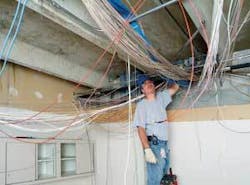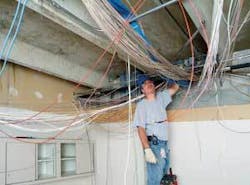Abandoned cable removal a dogged challenge for all
Unfortunately, for everyone involved, ignoring the issue won’t make it go away.
For just about a half- decade, the National Electrical Code has included language requiring the removal of cable from building pathways when that cable is not in current use or tagged for future use. The NEC defines this type of cable as “abandoned,” and mandates its removal, though not its method of removal.
Over the past five years, this and other cabling-trade publications have chronicled the development and modification of abandoned-cable removal requirements. More recently, trade publications focused on the profession of real-estate management have turned their attention to the topic as well, and with good reason. The glut of abandoned cables inside commercial office buildings today exists, at least in part, because of the transient nature of occupancy in such buildings.
Traditionally, when a tenant moves out of a building, it would leave the cabling in place-sometimes, several generations of it (e.g., Category 3, 5, 5e for some long-term tenants). And most often, a new tenant would install a new structured cabling system rather than rely on the cabling left by the previous occupant. That practice was great for the business of those organizations that manufacture, design, or install structured cabling systems. It was not so great, however, for the building pathways’ fuel loads-which led to the removal requirements.
Teamwork needed
As the past few years have shown, the entire situation has not been glorious for the owners of commercial buildings either. They essentially were left on the hook for the cost of removing years’, and in some cases decades’, worth of abandoned cable. The Building Owners and Managers Association International (BOMA International; www.boma.org) is a trade association that provides education and advocacy for property owners and managers, covering all types of buildings. The organization has adopted a position on the existence, and removal, of abandoned cable.
To quote BOMA’s position paper directly, “Building owners, managers, tenants, and service providers need to work cooperatively to ensure that all parties understand their responsibilities to comply with the National Electrical Code provisions on removing or tagging unused cabling in buildings.”
After providing some background information on the NEC provisions addressing abandoned cable-and noting that while the NEC itself is not law, many jurisdictions in the United States adopt the document by reference into local codes-BOMA requests specific action from its members.
Again, directly from the position paper: “BOMA International recommends that building owners and managers survey their buildings to identify unused cable. If such wires exist, members should identify the wiring by its rating (riser rated “CMR,” plenum rated “CMP”) and its use (communications, alarm, security, etc.). The NEC 2002 and 2005 include language that allows some cabling to be retained if it is tagged for future use as long as it meets the permitted use criteria specified for cable installations (i.e., minimum of “CMR” and/or “CMP”). Any cable that does not meet the permitted use specifications should be removed.
Leasing language
The BOMA paper continues: “Your leases should clearly state that tenants must remove any cabling that is abandoned during the term of their tenancy, and/or your license agreements should require service providers to remove all wires upon the termination of the contract. We recommend that you review your leases and license agreements to ascertain exactly who was responsible for the installation and/or abandoning of the cabling and whether you have recourse to recover any of the funds needed to remove the wire. Next, make any amendments necessary if you are not already protected by these agreements.”
As BOMA pointed out to its membership, abandoned cable is a code issue within those jurisdictions that have adopted the 2002 or 2005 NEC. As such, it is subject to enforcement by the local authority having jurisdiction.Though this author did not get an on-the-record comment concerning enforcement of abandoned-cable removal, some commented anonymously that enforcement varies from jurisdiction to jurisdiction.
Words getting in the way?
One potential reason for such unpredictable enforcement could be the sometimes-confounding wording within the NEC in which abandoned cable is referenced. The 2002 NEC includes seven separate sections that mandate the cable’s removal, and an accompanying seven individual sections that define the term “abandoned cable.”
The seven sections of NEC 2002 that contain the definitions are: 640.2, 725.2, 760.2, 770.2, 800.2, 820.2, and 830.2. The seven sections with the removal language are: 640.3, 725.3, 760.3, 770.3, 800.52, 820.3, and 830. The requirements for removal are worded essentially the same, as follows: “The accessible portion of abandoned [application for which cables are used, or cable type] cables shall not be permitted to remain.”
Simply, the code-based requirements to remove abandoned cables are not going away. How quickly those abandoned cables themselves are going away appears to depend on the tenacity of building owners/managers, along with the enforcement procedures of the local AHJ.

